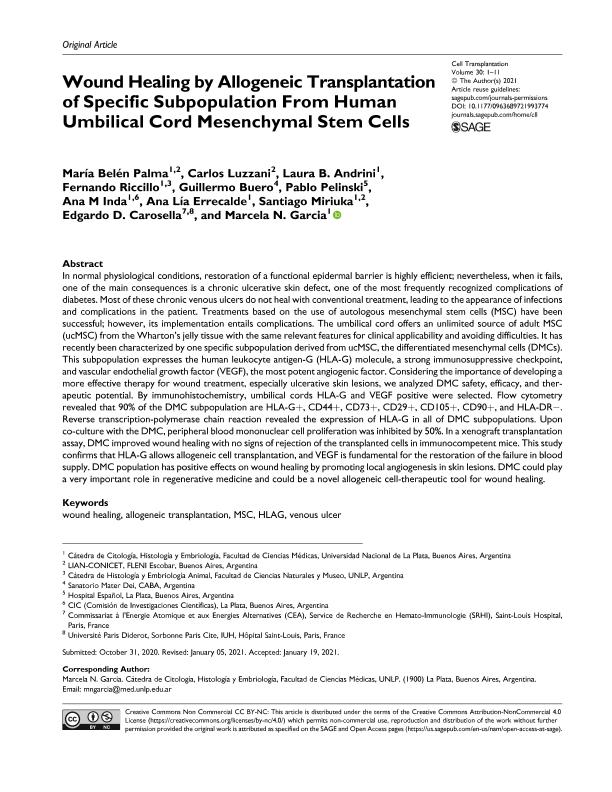Mostrar el registro sencillo del ítem
dc.contributor.author
Palma, Maria Belen

dc.contributor.author
Luzzani, Carlos Daniel

dc.contributor.author
Andrini, Laura Beatríz

dc.contributor.author
Riccillo, Fernando Luis

dc.contributor.author
Buero, Guillermo
dc.contributor.author
Pelinski, Pablo
dc.contributor.author
Inda, Ana María

dc.contributor.author
Errecalde, Ana Lia

dc.contributor.author
Miriuka, Santiago Gabriel

dc.contributor.author
Carosella, Edgardo Delfino

dc.contributor.author
García, Marcela Nilda

dc.date.available
2022-08-11T16:03:10Z
dc.date.issued
2021-05
dc.identifier.citation
Palma, Maria Belen; Luzzani, Carlos Daniel; Andrini, Laura Beatríz; Riccillo, Fernando Luis; Buero, Guillermo; et al.; Wound healing treatment by transplantation of umbilical cord mesenchymal stem cell subpopulation; SAGE Publications; Cell Transplantation; 30; 5-2021; 1-11
dc.identifier.issn
0963-6897
dc.identifier.uri
http://hdl.handle.net/11336/165234
dc.description.abstract
In normal physiological conditions, restoration of a functional epidermal barrier is highly efficient; nevertheless, when it fails, one of the main consequences is a chronic ulcerative skin defect, one of the most frequently recognized complications of diabetes. Most of these chronic venous ulcers do not heal with conventional treatment, leading to the appearance of infections and complications in the patient. Treatments based on the use of autologous mesenchymal stem cells (MSC) have been successful; however, its implementation entails complications. The umbilical cord offers an unlimited source of adult MSC (ucMSC) from the Wharton’s jelly tissue with the same relevant features for clinical applicability and avoiding difficulties. It has recently been characterized by one specific subpopulation derived from ucMSC, the differentiated mesenchymal cells (DMCs). This subpopulation expresses the human leukocyte antigen-G (HLA-G) molecule, a strong immunosuppressive checkpoint, and vascular endothelial growth factor (VEGF), the most potent angiogenic factor. Considering the importance of developing a more effective therapy for wound treatment, especially ulcerative skin lesions, we analyzed DMC safety, efficacy, and therapeutic potential. By immunohistochemistry, umbilical cords HLA-G and VEGF positive were selected. Flow cytometry revealed that 90% of the DMC subpopulation are HLA-G+, CD44+, CD73+, CD29+, CD105+, CD90+, and HLA-DR−. Reverse transcription-polymerase chain reaction revealed the expression of HLA-G in all of DMC subpopulations. Upon co-culture with the DMC, peripheral blood mononuclear cell proliferation was inhibited by 50%. In a xenograft transplantation assay, DMC improved wound healing with no signs of rejection of the transplanted cells in immunocompetent mice. This study confirms that HLA-G allows allogeneic cell transplantation, and VEGF is fundamental for the restoration of the failure in blood supply. DMC population has positive effects on wound healing by promoting local angiogenesis in skin lesions. DMC could play a very important role in regenerative medicine and could be a novel allogeneic cell-therapeutic tool for wound healing.
dc.format
application/pdf
dc.language.iso
eng
dc.publisher
SAGE Publications

dc.rights
info:eu-repo/semantics/openAccess
dc.rights.uri
https://creativecommons.org/licenses/by-nc/2.5/ar/
dc.subject
ALLOGENEIC TRANSPLANTATION
dc.subject
HLAG
dc.subject
MSC
dc.subject
VENOUS ULCER
dc.subject
WOUND HEALING
dc.subject.classification
Otras Medicina Clínica

dc.subject.classification
Medicina Clínica

dc.subject.classification
CIENCIAS MÉDICAS Y DE LA SALUD

dc.title
Wound healing treatment by transplantation of umbilical cord mesenchymal stem cell subpopulation
dc.type
info:eu-repo/semantics/article
dc.type
info:ar-repo/semantics/artículo
dc.type
info:eu-repo/semantics/publishedVersion
dc.date.updated
2022-08-09T17:30:46Z
dc.identifier.eissn
1555-3892
dc.journal.volume
30
dc.journal.pagination
1-11
dc.journal.pais
Estados Unidos

dc.journal.ciudad
Nueva York
dc.description.fil
Fil: Palma, Maria Belen. Consejo Nacional de Investigaciones Científicas y Técnicas; Argentina. Universidad Nacional de La Plata. Facultad de Ciencias Médicas. Departamento de Ciencias Morfológicas. Cátedra de Citología y Embriología A; Argentina. Fundación para la Lucha contra las Enfermedades Neurológicas de la Infancia; Argentina
dc.description.fil
Fil: Luzzani, Carlos Daniel. Consejo Nacional de Investigaciones Científicas y Técnicas; Argentina. Fundación para la Lucha contra las Enfermedades Neurológicas de la Infancia; Argentina
dc.description.fil
Fil: Andrini, Laura Beatríz. Universidad Nacional de La Plata. Facultad de Ciencias Médicas. Departamento de Ciencias Morfológicas. Cátedra de Citología y Embriología A; Argentina
dc.description.fil
Fil: Riccillo, Fernando Luis. Universidad Nacional de La Plata. Facultad de Ciencias Médicas. Departamento de Ciencias Morfológicas. Cátedra de Citología y Embriología A; Argentina. Universidad Nacional de La Plata. Facultad de Ciencias Naturales y Museo. Cátedra de Histología y Embriología Animal; Argentina
dc.description.fil
Fil: Buero, Guillermo. Sanatorio Mater Dei; Argentina
dc.description.fil
Fil: Pelinski, Pablo. Hospital Español; Argentina
dc.description.fil
Fil: Inda, Ana María. Provincia de Buenos Aires. Gobernación. Comisión de Investigaciones Científicas; Argentina. Universidad Nacional de La Plata. Facultad de Ciencias Naturales y Museo. Cátedra de Histología y Embriología Animal; Argentina
dc.description.fil
Fil: Errecalde, Ana Lia. Universidad Nacional de La Plata. Facultad de Ciencias Naturales y Museo. Cátedra de Histología y Embriología Animal; Argentina
dc.description.fil
Fil: Miriuka, Santiago Gabriel. Consejo Nacional de Investigaciones Científicas y Técnicas; Argentina. Fundación para la Lucha contra las Enfermedades Neurológicas de la Infancia; Argentina. Universidad Nacional de La Plata. Facultad de Ciencias Naturales y Museo. Cátedra de Histología y Embriología Animal; Argentina
dc.description.fil
Fil: Carosella, Edgardo Delfino. Université Paris Diderot - Paris 7; Francia. Commissariat à L?Énergie Atomique et aux Énergies Alternatives; Francia
dc.description.fil
Fil: García, Marcela Nilda. Universidad Nacional de La Plata. Facultad de Ciencias Naturales y Museo. Cátedra de Histología y Embriología Animal; Argentina
dc.journal.title
Cell Transplantation

dc.relation.alternativeid
info:eu-repo/semantics/altIdentifier/doi/http://dx.doi.org/10.1177/0963689721993774
dc.relation.alternativeid
info:eu-repo/semantics/altIdentifier/url/https://journals.sagepub.com/doi/10.1177/0963689721993774
Archivos asociados
